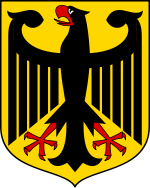Municipalities of Germany

The "pyramid" of German administrative subdivisions
| Germany |
 This article is part of the series: |
|
|
|
Constitution
Legislature
Judiciary
Executive
Divisions
Elections
Foreign policy
|
|
Other countries · Atlas |
Municipalities (Gemeinde) are the lowest level of territorial division in Germany. This may be the fourth level of territorial division in Germany, apart from those states which include Regierungsbezirke (singular: Regierungsbezirk), where municipalities then become the fifth level.
Contents |
Overview
With over than 3,400,000 inhabitants, the most populated one is the city of Berlin; and the lesser populated is Wiedenborstel (5 inhabitants in 2007), in Schleswig-Holstein.
Municipalities per federal state
List updated at August 1, 2009.
| Federal state | Municipalities | M. with city status |
Average nr. of inhabitants[1] |
Average surface (km²)[2] |
List (Cities, Towns, Municipalities) |
|---|---|---|---|---|---|
| Baden-Württemberg | 1,101 | 312 | 9,764 | 32.41 | C, T, M |
| Bavaria | 2,056 | 315 | 6,090 | 33.03 | C, T, M |
| Berlin | 1 | 1 | 3,416,255 | 891.02 | Berlin |
| Brandenburg | 419 | 112 | 6,052 | 70.36 | C, T, M |
| Bremen | 2 | 2 | 331,541 | 202.14 | Bremen, Bremerhaven |
| Hamburg | 1 | 1 | 1,770,629 | 755.16 | Hamburg |
| Hesse | 426 | 189 | 14,255 | 48.80 | C, T, M |
| Lower Saxony | 1,022 | 164 | 7,800 | 45.25 | C, T, M |
| Mecklenburg-Vorpommern | 818 | 84 | 2,053 | 28.34 | C, T, M |
| North Rhine-Westphalia | 396 | 268 | 45,446 | 86.08 | C, T, M |
| Rhineland-Palatinate | 2,306 | 123 | 1,754 | 8.61 | C, T, M |
| Saarland | 52 | 17 | 19,935 | 49.40 | C, T, M |
| Saxony | 491 | 178 | 8,595 | 37.51 | C, T, M |
| Saxony-Anhalt | 851 | 118 | 2,835 | 24.03 | C, T, M |
| Schleswig-Holstein | 1,116 | 63 | 2,542 | 14.07 | C, T, M |
| Thuringia | 955 | 126 | 2,397 | 16.93 | C, T, M |
| Germany | 12,013 | 2,073 | 6,844 | 29.35 | C, T, M |
References
See also
- List of municipalities in Germany
External links
 Media related to Municipalities of Germany at Wikimedia Commons
Media related to Municipalities of Germany at Wikimedia Commons
|
||||||||